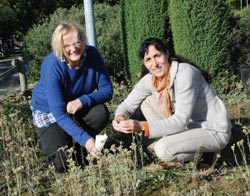Nationwide Network for the Protection of endangered Wild Plant Species

The Botanical Gardens in Germany will form a national network for the protection of endangered wild plant species. Foto: Osnabrueck University<br>
Prof. Dr. Sabine Zachgo, Director of the Botanical Garden of the Osnabrück University and Head of the Network commented: “This project will contribute to the requirements of the German National Biological Strategy and promote the implementation of the preservation of genetic diversity of wild species and the protection of regional adaptation”.
The project is being supported by the Federal Agency for Nature Conservation (BfN) with funds provided through the German Ministry for the Environment, Conservation and Nuclear Safety (BMU) to the sum of 2.4 million Euros for a period of five years. In co-operation with various organisations, i.e. nature conservation groups as well as foundations, the aim is to ensure the protection of 15 endangered species for which Germany has taken a special responsibility. These species include mountain arnica (Arnica montana), dune gentian (Gentianella uliginosa) and a native orchid, the western marsh orchid (Dactylorhiza majalis).
During the first phase of the project seed material from the 15 species will be collected nationwide from their wild habitats and stored in gene banks. Subsequently, the Botanical Gardens will propagate this material for use in a final third phase, which involves a close collaboration with conservation organisations to use this material to strengthen endangered populations in their natural habitat.
This project was initiated by the Botanical Garden of the Osnabrück University which co-ordinates since 2009 the “Genbank für Wildpflanzen für Ernährung und Landwirtschaft” [Gene Bank for Wild Plants for Nutrition and Agriculture]. Within this network four of the five network partners already work successfully together.
“The special character and innovation of this network lies in the combination of different protection measures for native wild plants. Each of the partner contributes by bringing into the network their own special and complementary expertise thereby generating synergistic effects”, comments Zachgo. The Botanical Garden of Osnabrück will, for example, develop a Geo-Web-Mapping tool. This will allow involving also community service volunteers, who will be able to mark locations of plants deserving protection and notify the network of these online.
This project falls within the period of the International Decade for Biodiversity, 2011 – 2020, which was called into being by the UN to realise the biodiversity strategy objective. Through a strategy of widely broadcasting information and inclusion of the public the “WIPs-Project” aims to strengthen the awareness of the importance to maintain the native biodiversity and to increase the willingness of the broad public to take part in its protection.
In addition to the presentation of this project at, amongst others, the national horticultural show in Brandenburg in 2015 and at the IGA 2017 in Berlin, the Botanical gardens involved in this project will exhibit the selected species in their own establishments and inform the visitors of the special characteristics and specific requirements of these 15 endangered species.
For more information:
Prof. Dr. Sabine Zachgo
Director of the Botanical Garden of the Osnabrück University
Barbarastraße 11, 49074 Osnabrück
Tel. +49 541 969 2840,
E-Mail: sabine.zachgo@biologie.uni-osnabrueck.de
Media Contact
More Information:
http://www.biologischevielfalt.de/18348.htmlAll latest news from the category: Life Sciences and Chemistry
Articles and reports from the Life Sciences and chemistry area deal with applied and basic research into modern biology, chemistry and human medicine.
Valuable information can be found on a range of life sciences fields including bacteriology, biochemistry, bionics, bioinformatics, biophysics, biotechnology, genetics, geobotany, human biology, marine biology, microbiology, molecular biology, cellular biology, zoology, bioinorganic chemistry, microchemistry and environmental chemistry.
Newest articles

High-energy-density aqueous battery based on halogen multi-electron transfer
Traditional non-aqueous lithium-ion batteries have a high energy density, but their safety is compromised due to the flammable organic electrolytes they utilize. Aqueous batteries use water as the solvent for…

First-ever combined heart pump and pig kidney transplant
…gives new hope to patient with terminal illness. Surgeons at NYU Langone Health performed the first-ever combined mechanical heart pump and gene-edited pig kidney transplant surgery in a 54-year-old woman…

Biophysics: Testing how well biomarkers work
LMU researchers have developed a method to determine how reliably target proteins can be labeled using super-resolution fluorescence microscopy. Modern microscopy techniques make it possible to examine the inner workings…





















